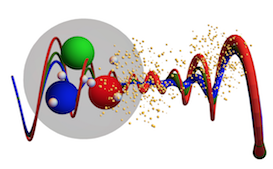Speaker
Description
Measurements of charm and beauty production in proton-proton (pp) collisions are an important test of perturbative QCD calculations, based on the factorisation approach. Recent results of charm baryon-to-meson ratios in pp collisions at midrapidity have highlighted a significant enhancement of these ratios compared to measurements in e+e– collisions, suggesting that the fragmentation of charm quarks into mesons is not universal across different collision systems.
The study of open and hidden heavy-flavour hadron production in pp collisions as a function of the charged-particle multiplicity is a powerful tool to study the interplay between hard and soft QCD processes responsible for particle production in hadronic collisions and to retrieve information on the role of multi-parton interactions in heavy-flavour production. Furthermore, recent LHC results highlighted the presence of collective-like effects among the particles produced in high-multiplicity pp and proton-lead (p–Pb) collisions, similarly to what observed in heavy-ion collisions, where a quark-gluon plasma state is produced. Extending these studies to the heavy-flavour sector is crucial for a better understanding of the source of these features, which is currently debated.
The excellent capabilities of the ALICE experiment for particle identification, track and decay-vertex reconstruction allow us to precisely reconstruct a large set of heavy-flavour species down to very low transverse momentum.
In this contribution, the latest ALICE results of open heavy-flavour and quarkonium production will be discussed and compared to predictions from different models. A particular focus will be given to measurements of baryon-to-meson production yields in the charm sector in pp collisions, self-normalised yields of open and hidden heavy-flavour hadrons as a function of the event multiplicity in pp collisions, and elliptic-flow coefficient in high-multiplicity pp and p–Pb collisions.

